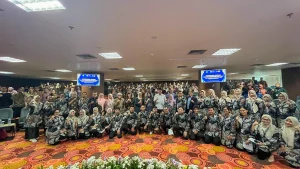Baluran National Park in Banyuwangi, East Java, is a popular national park. The number of domestic and foreign tourists always increases every year. This national park was visited by 11,780 tourists in 2005 and 2015, the total visitors to Baluran National Park reached 93 thousand.
The increasing number of tourists into the national park area is undeniably having many positive impacts. However, it also poses some risks. One of them is the risk of vector-borne disease. The vector-borne disease is a disease in which pathogenic microorganisms are transmitted from infected individuals to other individuals through disease vectors, sometimes through animals as host intermediaries.
Some types of Arthropods act as vectors of pathogenic bacteria that can cause disease in domestic animals, wild animals, and humans. Some animals are reservoirs of these pathogenic microbes and play an essential role in their transmission both among and between species. Dengue, yellow fever, chikungunya, malaria, and zika virus are examples of diseases carried by Arthropod vectors.
Lizards ( Varanus spp.) are one of the animals that can be found both in Baluran National Park and are identified as competent hosts for Rickettsia bacteria and the Hepatozoon group protozoa. Lizards in two national parks are attacked by ectoparasites such as ticks of Acarina group which have not been identified. Ticks are known as ectoparasites in several types of vertebrates, and various types of ticks are associated with the spread of disease. Accurate identification of tick species is the basis of tick-borne disease control.
In simple terms, identification of tick species can be made through morphological observation. Morphological features in its adult phase can be used as the main criteria for identifying ectoparasites. However, morphological observation is a problem because specimens can undergo morphological changes before and after sucking blood from a host or are in the pre-adult phase.
Ectoparasites are part of the Ixodidae family consisting of 900 species. So the morphological observation is quite difficult to do and takes a lot of time. Moreover, adjacent flea species have high morphological similarities and are often difficult to distinguish even if it is carried out by a taxonomist. A new method for identifying species has been developed, called DNA barcoding. DNA barcoding is a popular taxonomic method today using short genetic markers in the DNA of an organism and is used to identify a specimen.
This research was carried out by collecting ticks on lizard skin, which was then followed by isolation of the tick DNA, amplification of the cytochrome oxidase subunit I (COI) gene which was then followed by an analysis of the nucleotide base sequence of the gene. The COI gene base sequence obtained was then identified by a database on Genbank ( www.ncbi.nlm.gov/genbank ) to determine the type of the ectoparasites.
There were some results from this research. First, the species of ectoparasite infestation in Varanus spp. Based on the results of DNA barcoding analysis using the cytochrome oxidase subunit I (COI) gene in Baluran National Park, including the type Amblyomma sp. Second, the type of ectoparasites Amblyomma sp. found in all parts of the body of Varanus spp., such as the head, body, tail and legs.
The objective to be achieved is to detect the presence of pathogenic microbes, both in the body of ectoparasites or in the body of Varanusspp, which was done using DNA barcoding. In some referred studies, the Amblyomma type has the potential as a host of several microbial pathogens, including the types of Rickettsia, Borrelia, and Cowdria ruminantium .
Author: M. Hilman Fu’adil Amin
Details of this article can be seen in our publication at http://www.envirobiotechjournals.com/article_abstract.php?aid=9479&iid=271&jid=3









